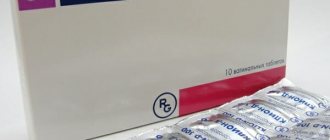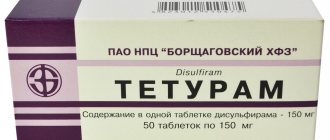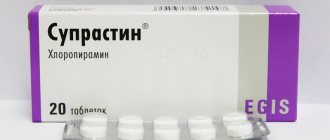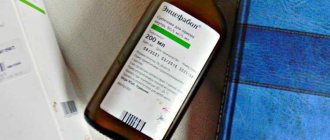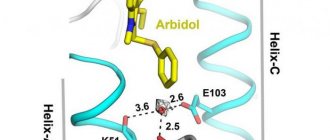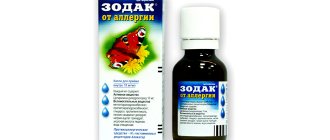Pharmacodynamics and pharmacokinetics
Pharmacodynamics
Advil is a non-steroidal anti-inflammatory drug. It has a pronounced anti-inflammatory, antipyretic and analgesic effect.
The mechanism of action is explained by the non-selective blockade of cyclooxygenases (COX1 and COX2), enzymes that are involved in the metabolism of arachidonic acid, a precursor of prostaglandins, which play a major role in the development of pain and inflammation.
The analgesic effect is associated with the peripheral and central mechanism of suppression of prostaglandin synthesis. Affects platelet aggregation, suppressing it.
The drugs of choice for fever in children are Paracetamol and Ibuprofen , which is used when the former is ineffective.
Pharmacokinetics
After oral administration, it is completely absorbed from the gastrointestinal tract. Eating slightly slows down absorption. Metabolized in the liver. T1/2 - 2-3.5 hours. Most of the dose is excreted in the urine: 70% in the form of metabolites, 10% unchanged. The remaining 20% of the active substance in the form of metabolites is excreted through the intestines.
Advil Lyqi-jels capsule
Instructions for medical use of the drug
Description of pharmacological action
NSAIDs, a derivative of phenylpropionic acid. It has anti-inflammatory, analgesic and antipyretic effects.
Indications for use
Inflammatory and degenerative diseases of the joints and spine (including rheumatic and rheumatoid arthritis, ankylosing spondylitis, osteoarthritis), articular syndrome with exacerbation of gout, psoriatic arthritis, ankylosing spondylitis, tendinitis, bursitis, radiculitis, traumatic inflammation of soft tissues and musculoskeletal apparatus. Neuralgia, myalgia, pain syndrome due to infectious and inflammatory diseases of the ENT organs, adnexitis, algodismenorrhea, headache and toothache. Fever in infectious and inflammatory diseases.
Release form
capsules 400 mg; blister 2, cardboard pack 1. capsules 400 mg; blister 4, cardboard pack 1. capsules 400 mg; blister 8, cardboard pack 1. capsules 400 mg; blister 10, cardboard pack 1. capsules 400 mg; blister 20, cardboard pack 2.
Pharmacodynamics
The mechanism of action is associated with inhibition of the activity of COX, the main enzyme in the metabolism of arachidonic acid, which is a precursor of prostaglandins, which play a major role in the pathogenesis of inflammation, pain and fever. The analgesic effect is due to both peripheral (indirectly, through suppression of prostaglandin synthesis) and central mechanisms (due to inhibition of prostaglandin synthesis in the central and peripheral nervous system). Suppresses platelet aggregation. When applied externally, it has an anti-inflammatory and analgesic effect. Reduces morning stiffness and helps increase range of motion in joints.
Pharmacokinetics
When taken orally, ibuprofen is almost completely absorbed from the gastrointestinal tract. Concomitant food intake slows down the rate of absorption. Metabolized in the liver (90%). T1/2 is 2-3 hours. 80% of the dose is excreted in the urine mainly in the form of metabolites (70%), 10% - unchanged; 20% is excreted through the intestines in the form of metabolites.
Use during pregnancy
Contraindicated in the third trimester of pregnancy, in the first and second trimesters - with caution. Breastfeeding should be stopped during treatment.
Contraindications for use
Erosive and ulcerative lesions of the gastrointestinal tract in the acute phase, diseases of the optic nerve, “aspirin triad”, hematopoietic disorders, severe renal and/or liver dysfunction; hypersensitivity to ibuprofen.
Side effects
From the digestive system: often - nausea, anorexia, vomiting, discomfort in the epigastrium, diarrhea; possible development of erosive and ulcerative lesions of the gastrointestinal tract; rarely - bleeding from the gastrointestinal tract; With long-term use, liver function disorders are possible. From the central nervous system and peripheral nervous system: often - headache, dizziness, sleep disturbances, agitation, visual disturbances. From the hematopoietic system: with long-term use, anemia, thrombocytopenia, and agranulocytosis are possible. From the urinary system: with long-term use, renal dysfunction is possible. Allergic reactions: often - skin rash, Quincke's edema; rarely - aseptic meningitis (more often in patients with autoimmune diseases), bronchospastic syndrome. Local reactions: when used externally, skin hyperemia, burning or tingling sensations are possible.
Directions for use and doses
They are set individually, depending on the nosological form of the disease and the severity of clinical manifestations. When taken orally or rectally for adults, the single dose is 200-800 mg, the frequency of administration is 3-4 times/day; for children - 20-40 mg/kg/day in several doses. Apply externally for 2-3 weeks. The maximum daily dose for adults when taken orally or rectally is 2.4 g
Interactions with other drugs
With simultaneous use, ibuprofen reduces the effect of antihypertensive drugs (ACE inhibitors, beta-blockers), diuretics (furosemide, hydrochlorothiazide). When used simultaneously with anticoagulants, their effect may be enhanced. When used simultaneously with GCS, the risk of side effects from the gastrointestinal tract increases. When used simultaneously, ibuprofen can displace indirect anticoagulants (acenocoumarol), hydantoin derivatives (phenytoin), and oral hypoglycemic drugs, sulfonylurea derivatives, from compounds with blood plasma proteins. When used simultaneously with amlodipine, a slight decrease in the antihypertensive effect of amlodipine is possible; with acetylsalicylic acid - the concentration of ibuprofen in the blood plasma decreases; with baclofen - a case of increased toxic effects of baclofen has been described. When used simultaneously with warfarin, an increase in bleeding time is possible; microhematuria and hematomas were also observed; with captopril - the antihypertensive effect of captopril may be reduced; with cholestyramine - a moderate decrease in the absorption of ibuprofen. When used simultaneously with lithium carbonate, the concentration of lithium in the blood plasma increases. When used simultaneously with magnesium hydroxide, the initial absorption of ibuprofen increases; with methotrexate - the toxicity of methotrexate increases.
Special instructions for use
Use with caution in case of concomitant diseases of the liver and kidneys, chronic heart failure, with dyspeptic symptoms before starting treatment, immediately after surgery, with indications in the anamnesis of bleeding from the gastrointestinal tract and gastrointestinal diseases, allergic reactions associated with taking NSAIDs. During treatment, systematic monitoring of liver and kidney functions and peripheral blood patterns is necessary. Should not be used externally on damaged skin areas.
Storage conditions
At a temperature not exceeding 30 °C.
Best before date
24 months
ATX classification:
M Musculoskeletal system
M01 Anti-inflammatory and antirheumatic drugs
M01A Non-steroidal anti-inflammatory drugs
M01AE Propionic acid derivatives
M01AE01 Ibuprofen
Indications for use
- degenerative and inflammatory diseases of the joints: psoriatic and gouty arthritis , rheumatoid arthritis , ankylosing spondylitis , spondylosis , osteoarthritis ;
- pain syndrome with lumbodynia , sciatica , myalgia , bursitis, ossalgia, tendinitis, tendovaginitis , sprains and injuries of the ligamentous apparatus, after operations;
- toothache, migraine ;
- febrile conditions ( flu , ARVI , after immunization ).
As an adjuvant, Advil is prescribed for diseases of the ENT organs ( pharyngitis , laryngitis , tonsillitis , sinusitis ), bronchitis , pneumonia , adnexitis , algodismenorrhea , nephrotic syndrome (reduces the severity of proteinuria ).
Dosage
Advil is taken orally only after meals. The dose depends on the disease and the individual characteristics of the body. For example, in the treatment of osteoarthritis, psoriatic arthritis and ankylosing spondylitis, the dosage is from 400 to 600 mg per dose, three to four times a day.
For rheumatoid arthritis, the dosage is 800 mg, three times throughout the day. In the presence of injuries or sprains - from 1.6 to 2.4 g per day. For painful menstruation - 400 mg, up to 4 times a day. For mild pain in other diseases, as well as for moderate toothache, the dose is 1.2 g per day.
The suspension is used in the treatment of children aged 6 - 12 months. However, before giving medicine to a child, it is necessary to consult a specialist. It can also be used when body temperature rises after vaccination. In this case, the dose is 50 mg. This same dose can be repeated, but no more than 100 mg should be used per day.
Contraindications
Advil tablets are contraindicated for:
- erosive and ulcerative lesions of the gastrointestinal tract;
- bleeding disorders, leukopenia, hemorrhagic diathesis , thrombocytopenia;
- “aspirin” bronchial asthma, urticaria and rhinitis caused by taking NSAIDs;
- scotoma , amblyopia , diseases of the optic nerve, color vision disorders;
- hyperkalemia;
- progressive kidney diseases and renal failure ;
- severe liver failure ;
- heart failure;
- under 6 years of age (for taking tablets and capsules);
- hypersensitivity to the drug.
Similar drugs:
- Carsil Dragee
- Ascorutin Oral tablets
- Yogurt Capsule
- Ergoferon () Lozenges
- Magne B6 Oral tablets
- Omez Capsule
- Papaverine Oral tablets
** The Drug Directory is intended for informational purposes only. For more complete information, please refer to the manufacturer's instructions. Do not self-medicate; Before you start using Advil Liquidgels, you should consult your doctor. EUROLAB is not responsible for the consequences caused by the use of information posted on the portal. Any information on the site does not replace medical advice and cannot serve as a guarantee of the positive effect of the drug.
Are you interested in Advil Liqui-gels? Do you want to know more detailed information or do you need a doctor's examination? Or do you need an inspection? You can make an appointment with a doctor - the Euro lab is always at your service! The best doctors will examine you, advise you, provide the necessary assistance and make a diagnosis. You can also call a doctor at home . Euro lab clinic is open for you around the clock.
** Attention! The information presented in this medication guide is intended for medical professionals and should not be used as a basis for self-medication. The description of the drug Advil Liquid-gels is provided for informational purposes only and is not intended for prescribing treatment without the participation of a doctor. Patients need to consult a specialist!
If you are interested in any other drugs and medications, their descriptions and instructions for use, information about the composition and form of release, indications for use and side effects, methods of use, prices and reviews of drugs, or you have any other questions and suggestions - write to us, we will definitely try to help you.
Side effects
Advil may cause:
- nausea, vomiting, loss of appetite, pain in the stomach and abdomen, erosive and ulcerative lesions of the gastrointestinal tract, dryness of the oral mucosa and its ulceration, aphthous stomatitis , constipation/diarrhea, flatulence ;
- headache, anxiety, nervousness, psychomotor agitation, hallucinations , confusion, hearing loss, blurred vision or double vision, swelling of the conjunctiva and eyelids;
- shortness of breath , bronchospasm;
- tachycardia , increased blood pressure;
- eosinophilia , anemia , leukopenia , agranulocytosis ;
- edema, cystitis , polyuria, renal dysfunction;
- skin rash, itching, urticaria, angioedema , allergic rhinitis , anaphylactic shock , toxic epidermal necrolysis .
special instructions
Use with caution in the presence of kidney and liver diseases, chronic heart failure, dyspeptic syndrome, after surgery.
Can I take it during pregnancy and lactation?
The annotation states that the use of ibuprofen-based medicine is possible in the first and second trimesters. The dosage and duration of treatment are prescribed by the doctor. The third trimester is an absolute contraindication.
You can take the medication during breastfeeding. The active substance passes into breast milk in small quantities, so the negative impact on the baby is minimized.
Use in childhood
Children under 6 years of age are an absolute contraindication for tablets, dragees and capsules. It is better to give a suspension to young children. The dosage is calculated based on body weight: 20-40 mg of active substance per 1 kg of weight. The resulting quantity is designed for several doses.
Can I take it if I have impaired renal function?
An absolute contraindication is renal failure. Take with caution in case of kidney disease and organ dysfunction.
For liver dysfunction
Not prescribed to patients with liver failure. Use with caution for liver cirrhosis or hepatitis.
Overdose
Manifested by symptoms: headache, lethargy, tinnitus, drowsiness, abdominal pain, nausea, vomiting, renal failure , bradycardia , tachycardia , hypotension , atrial fibrillation .
Treatment: gastric lavage is performed, which is effective within the first hour after taking high doses, taking sorbents, alkaline drinking, blood pressure correction, and if there is gastrointestinal bleeding measures are taken to stop it.
Pharmacological properties of the drug Advil
The medication has an analgesic, anti-inflammatory and antipyretic effect. The analgesic property is expressed in severe painful sensations that manifest themselves as a result of the development of the inflammatory process.
Pharmacodynamics
The drug belongs to the category of non-steroidal anti-inflammatory drugs. The mechanism of action is to block enzymes that take part in the metabolic processes of arachidonic acid. The medication has an analgesic effect, thereby suppressing the synthesis of prostaglandins. Suppresses platelet aggregation.
Pharmacokinetics
After internal use, it is quickly absorbed by the intestinal walls. When eating food, the absorption process slows down. Passes through the liver. Reaches maximum concentration after 2-3 hours. It is excreted in urine in the form of metabolites and in feces in an unchanged form.
Interaction
Cholestyramine causes a moderate decrease in ibuprofen . Acetylsalicylic acid reduces the concentration of ibuprofen in the blood.
When used with GCS, the risk of adverse reactions from the gastrointestinal tract increases.
Advil tablets, when used together with Warfarin, cause an increase in bleeding time, microhematuria , the appearance of hematomas , and with Baclofen - an increase in its toxic effect.
When used simultaneously with Captopril , Amlodipine and diuretics , their hypotensive effect is slightly reduced.
When used simultaneously with Methotrexate, its toxicity also increases.
When used with lithium, its concentration in the blood increases.
Ibuprofen displaces oral hypoglycemic drugs , indirect anticoagulants , and phenytoin .
Drug interactions
The drug reduces the therapeutic effect of diuretics, as well as drugs aimed at treating hypertension. There is an increase in the effect of anticoagulants with simultaneous use of capsules.
The combined use of tablets and glucocorticosteroids leads to the risk of side effects from the gastrointestinal tract. The medication prevents the processes of binding the active substances of drugs belonging to the group of anticoagulants, hypoglycemic agents, and hydantoin derivatives.
Concomitant use with amlodipine leads to a decrease in the therapeutic effectiveness of the antihypertensive drug.
Other interactions:
- Aspirin - decreases the concentration of the active component of Advil.
- Baclofen – toxic effects.
- Warfarin – increased bleeding time, hematoma formation, microhematuria.
- Captopril – decreased antihypertensive activity.
- Metatrexate – increased toxicity.
- Colesteramine – reduces the absorption time of the active component.
Lithium preparations temporarily increase the concentration of the substance in the blood. The level of absorption of ibuprofen increases with simultaneous use of the drug with magnesium hydroxide.
Analogs
Level 4 ATC code matches:
Artrum
Brustan
Ketonal Duo
Nurofen Plus
Nurofen Express
Nurofen Forte
Nurofen Express Lady
Nurofen for children
Nurofen
Ibuprom
Ibuprofen
Mig 400
Has
Ketoprofen
Vimovo
Naproxen
Flexen
Nalgesin
Flamax
Novigan
ArthroKam , Bonifen , Burana , Iprene , Brufen Retard , MIG 200 and 400 , Sedalgin SPRINT , Solpaflex , Ibufen (suspension for children) , Nurofen forte .
Reviews
Advil, what is it? This is a non-steroidal anti-inflammatory drug with the active ingredient ibuprofen , which is considered the safest and most effective NSAID. In addition to the action characteristic of all drugs in this group, it also increases the body’s nonspecific resistance and has an immunostimulating effect . Advil is indifferent to metabolic processes in cartilage - it does not disrupt the metabolism of articular cartilage, compared to aspirin and indomethacin .
Of all NSAIDs, it is best tolerated. Significantly less effect on the gastrointestinal tract than acetylsalicylic acid . Rare adverse reactions include gastropathy with nausea and vomiting, and these symptoms depend on the dose. According to statistics, ibuprofen is 3.2 times less likely than aspirin to cause adverse reactions and 4.5 times less likely than indomethacin. Advil is the drug of choice for an acute attack of gout, but the dose is 800 mg 3-4 times a day.
You need to know that this drug is potentially dangerous for patients with gastritis , peptic ulcers , liver disease, asthma and those with a tendency to bleed.
If we compare this drug with coxibs (celecoxib, rofecoxib), then their use is much less likely to cause gastrointestinal complications. This makes them the drug of choice in patients with an increased risk of gastroduodenal diseases. In addition, celecoxib has less effect on blood pressure destabilization.
Release forms and composition of the drug
The medicine is produced in the form of effervescent soluble tablets. Their main active ingredient is ibuprofen.
Additional components:
- 0.3 g potassium carbonate;
- 0.01 g anhydrous sodium carbonate;
- 0.33 g citric acid;
- 0.29 g monosodium citrate;
- 1.34 g sodium bicarbonate;
- 0.04 g sodium saccharinate;
- 0.01 g sucrose palminate;
- 0.01 g menthol flavoring;
- 0.04 g flavoring (grapefruit flavor);
- magnesium stearate – until the capsule weight is 2.8 g.
The product is packaged in aluminum strips and packaged in cardboard boxes.



